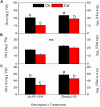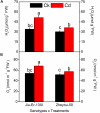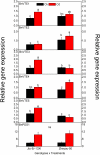Indigenous Tocopherol Improves Tolerance of Oilseed Rape to Cadmium Stress
- PMID: 33193479
- PMCID: PMC7644955
- DOI: 10.3389/fpls.2020.547133
Indigenous Tocopherol Improves Tolerance of Oilseed Rape to Cadmium Stress
Abstract
Two oilseed rape genotypes (Jiu-Er-13XI and Zheyou-50), differing in seed oil content, were subjected to cadmium (Cd) stress in hydroponic experiment. Genotypic differences were observed in terms of tolerance to Cd exposure. Cd treatment negatively affected both genotypes, but the effects were more devastating in Jiu-Er-13XI (low seed oil content) than in Zheyou-50 (high seed oil content). Jiu-Er-13XI accumulated more reactive oxygen species (ROS), which destroyed chloroplast structure and decreased photosynthetic pigments, than Zheyou-50. Total fatty acids, especially 18:2 and 18:3, severely decreased as suggested by increase in MDA content. Roots and shoots of Jiu-Er-13XI plants accumulated more Cd content, while less amount of tocopherol (Toc) was observed under Cd stress, than Zheyou-50. Conversely, Zheyou-50 was less affected by Cd stress than its counterpart. It accumulated comparatively less amount of Cd in roots and shoots, along with reduced accumulation of malondialdehyde (MDA) and ROS under Cd stress, than Jiu-Er-13XI. Further, the level of Toc, especially α-Tocopherol, was much higher in Zheyou-50 than in Jiu-Er-13XI, which was also supported by high expression of Toc biosynthesis genes in Zheyou-50 during early hours. Toc not only restricted the absorption of Cd by roots and its translocation to shoot but also scavenged the ROS generated during oxidative stresses. The low level of MDA shows that polyunsaturated fatty acids in chloroplast membranes remained intact. In the present study the tolerance of Zheyou-50 to Cd stress, over Jiu-Er-13XI, is attributed to the activities of Toc. This study shows that plants with high seed oil content are tolerant to Cd stress due to high production of Toc.
Keywords: cadmium stress; oilseed rape; pigments; tocopherols; ultrastructure.
Copyright © 2020 Ali, Hassan, Irfan, Hussain, Rehman, Shah, Shahzad, Ali, Alkahtani, Abdel-Daim, Bukhari and Ali.
Figures







References
-
- Ahmad P., Nabi G., Ashraf M. (2011). Cadmium-induced oxidative damage in mustard (Brassica juncea L.) Czern & Coss) plants can be alleviated by salicylic acid. South Afr. J. Bot. 77 36–44. 10.1016/j.sajb.2010.05.003 - DOI
-
- Ali E., Maodzeka A., Hussain N., Shamsi I. H., Jiang L. (2015). The alleviation of cadmium toxicity in oilseed rape (Brassica napus) by the application of salicylic acid. Plant Growth Regul. 75 641–655. 10.1007/s10725-014-9966-0 - DOI
-
- Borges R., Miguel E. C., Dias J. M. R., Da C. M., Ricardo E. B. S., Oliveira J. G., et al. (2004). Ultrastructural, physiological and biochemical analyses of chlorate toxicity on rice seedlings. Plant Sci. 166 1057–1062. 10.1016/j.plantsci.2003.12.023 - DOI
LinkOut - more resources
Full Text Sources

